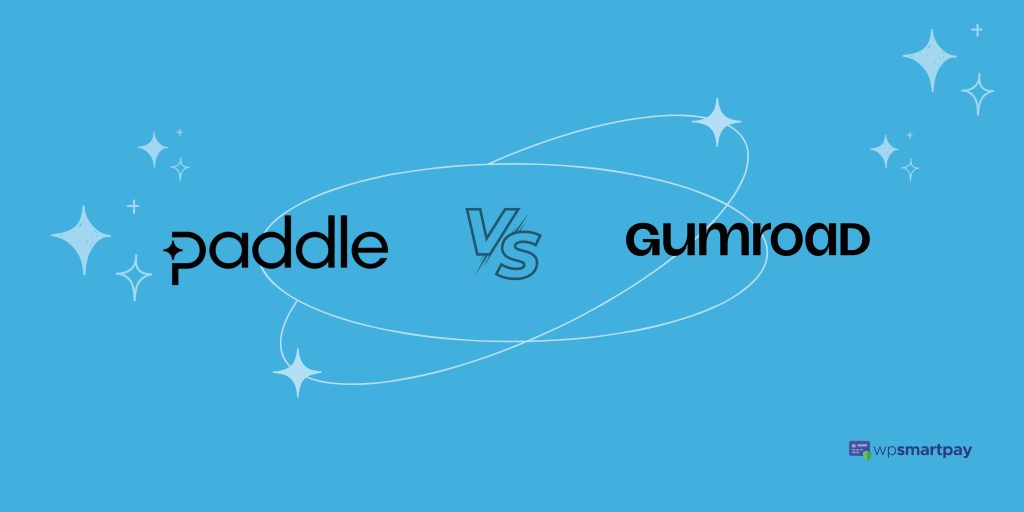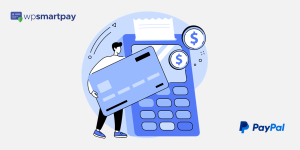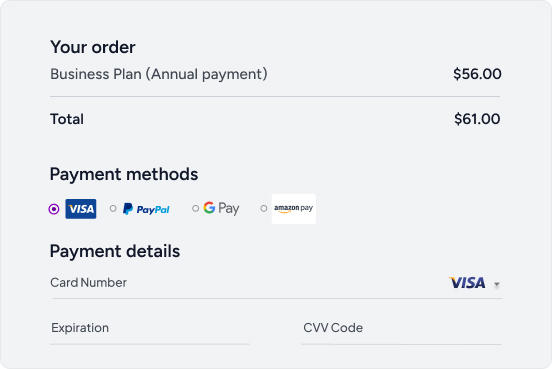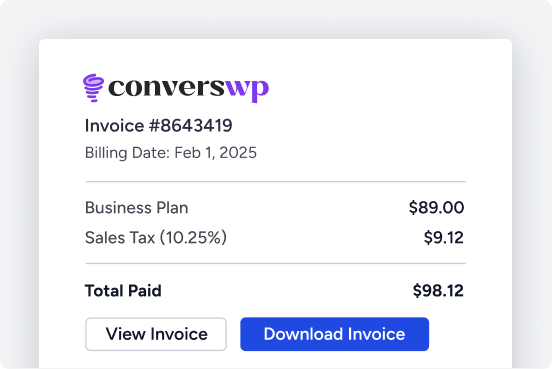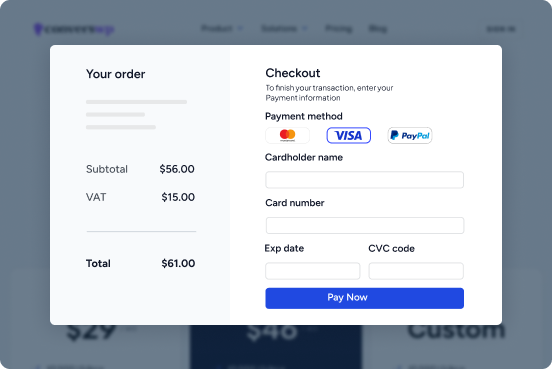 Key Takeaways
Key Takeaways
- This table breaks down their key features to help you decide which one best suits your needs
In the rapidly growing ecosystem of digital product sales and online course platforms, two names stand out: Paddle and Gumroad. While both enable creators and businesses to sell their digital wares directly to their audience, their approaches and feature sets cater to different needs.
Paddle positions itself as a merchant of record, handling compliance and regulatory requirements, allowing businesses to focus on their core offerings. Gumroad, on the other hand, offers a more streamlined, lightweight approach, making it easier for individual creators to quickly set up and start selling digital products.
This article delves deep into the unique characteristics of Paddle vs Gumroad, comparing their pricing models, features, integrations, and suitability for various business models. Whether you’re a startup or an established enterprise, this comprehensive analysis aims to help you make an informed decision that aligns with your goals and scaling aspirations.
What are Paddle and Gumroad?
Paddle
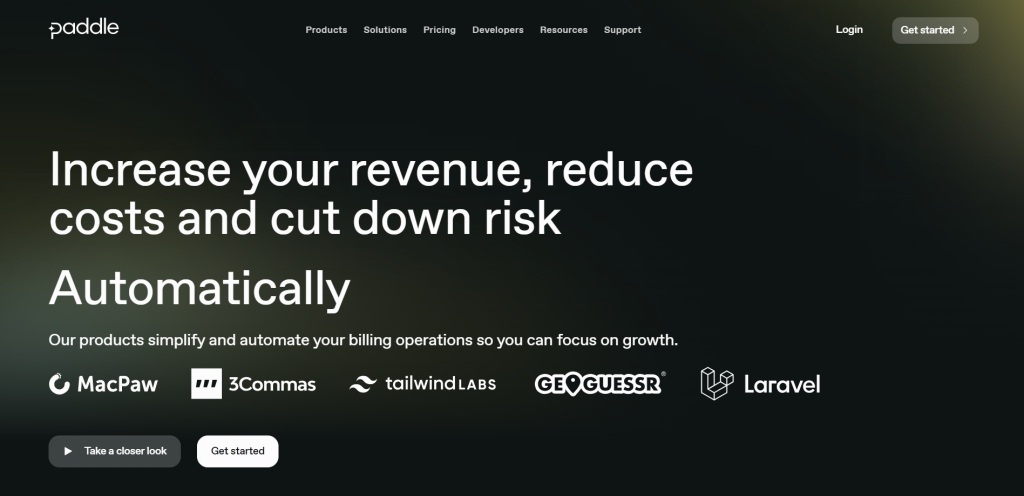
Paddle is a robust payment platform that focuses exclusively on providing an end-to-end payments infrastructure tailored for SaaS, software subscription, and digital goods merchants. It excels at handling global sales, including subscriptions, one-time transactions, and complex tax compliance like VAT. Whether you’re a SaaS provider, software platform, or digital product vendor, Paddle offers powerful features and seamless scalability to support your growth.
Key Features
- 5% + 0.50¢ per sale flat rate pricing
- Built-in sales tax compliance for Europe, US, Canada, and Australia
- Localized checkout options across 200+ countries and multiple currencies
- Automated VAT collection, filing and verification capabilities
- Focused subscription monetization tools like metered billing and instant license generation
- One-click instant payouts directly to all major banks globally
- Streamlined affiliate program and partner payout management
- Painless transparent platform pricing with sliding fee scale models
Of course, their comprehensive security standards make the list too – PCI DSS Level 1 compliance, bank-level encryption, extensive fraud protection and high service uptime guarantees.
Best Use Cases
- SaaS Companies: Manage global subscriptions and tax complexities effortlessly.
- Software Platforms: Offer secure and convenient purchasing options for digital products.
- Digital Product Vendors: Streamline sales processes and focus on creating amazing products.
Gumroad
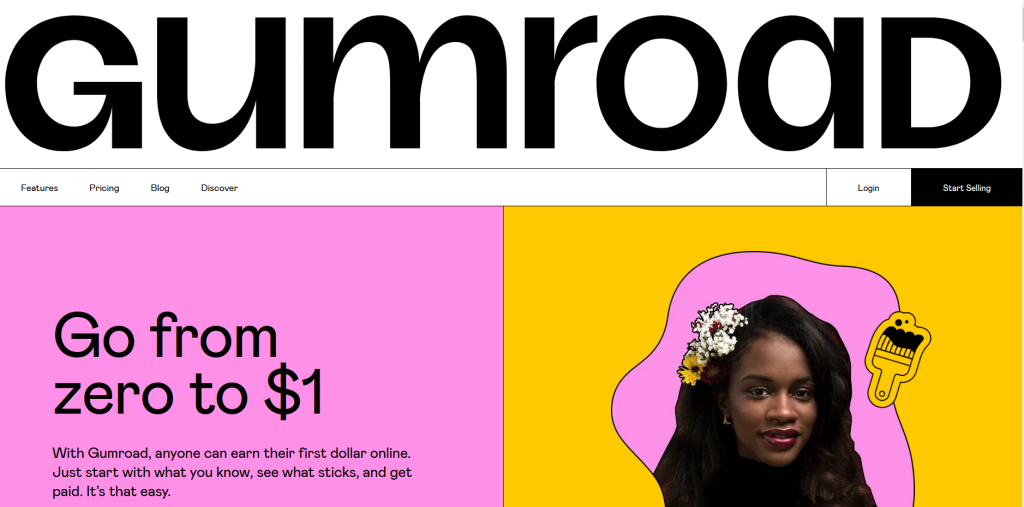
Gumroad is a powerful yet simple e-commerce platform designed specifically for creators, allowing them to sell a wide range of digital products and services directly to their audience. With a focus on ease of use and flexibility, Gumroad provides a comprehensive set of tools to help creators launch, manage, and grow their online businesses.
Key Features
- 10% flat rate pricing on every sale, no monthly fees
- Offers a streamlined process for creators to list and sell digital products, online courses, memberships, and more, with minimal setup required.
- Creators can either build a customizable storefront using Gumroad’s flexible page editor or easily integrate the platform with their existing website.
- Supports a variety of payment models, including one-time purchases, subscriptions, pay-what-you-want pricing, and multi-currency transactions
- Includes features like email marketing, audience management, coupon codes, and affiliate programs to help creators promote their offerings and grow their customer base
- For software and digital content creators, Gumroad offers license key generation and lightweight DRM options to protect their intellectual property
- Gumroad provides sales analytics and data insights to help creators understand their customers’ behavior and optimize their offerings
Gumroad secures transactions with TLS encryption exceeding industry standards and uses PCI compliant service providers for safe payments. Creators can further protect digital goods with unique download links, IP tracking, and watermarking.
Best Use Cases
- Independent Creators: Authors, artists, musicians, and other creatives looking to monetize their digital works with minimal technical overhead.
- Online Course Instructors: Educators and experts offering self-paced online courses, educational resources, or membership-based content.
- Software Developers: Developers selling software, apps, or digital products and requiring license key management and basic DRM capabilities.
- Small Businesses and Entrepreneurs: Small teams or solo entrepreneurs selling digital goods, services, or memberships directly to customers.
Paddle Vs Gumroad: Features and Functionality
Choosing the right platform to sell your digital products can be tricky. Here’s a head-to-head comparison of two popular options: Paddle vs Gumroad. This table breaks down their key features to help you decide which one best suits your needs. Consider factors like your target audience, feature requirements, and technical expertise.
| Features | Paddle | Gumroad |
|---|---|---|
| Target Audience | Ambitious online businesses, SaaS providers, software platforms, digital product vendors, WordPress-based eCommerce and digital download businesses (Paddle for EDD and Paddle for WooCommerce) | Creators selling digital products (ebooks, courses, music, etc.), memberships, and online services |
| Global Reach | 200+ currencies, localized checkout experiences | Supports multi-currency transactions |
| Subscriptions | Powerful management tools, flexible pricing plans, churn reduction strategies | Basic subscription features, limited management tools |
| Tax Compliance | Handles VAT and other regional taxes | Tax collection limited to the US, EU/UK, Australia & Singapore, India |
| Security | Robust PCI-DSS compliance, advanced fraud prevention, data encryption | PCI DSS compliance, TLS encryption, fraud prevention tools |
| Scalability | Handles high transaction volumes, scales with your business | Handles moderate transaction volumes but may require additional solutions for high volumes |
| Ease of Use | User-friendly interface, but requires some technical knowledge | Very user-friendly interface, minimal technical knowledge required |
| Built-in Marketing Tools | Limited integrations with marketing platforms | Email marketing, coupons, affiliate programs |
| Mobile-First | Mobile-optimized checkout | Mobile-optimized checkout |
| Pricing | Transaction fees + potential volume discounts | Flat 10% transaction fee on the sales price of all products sold |
| Hidden Fees | None | None |
| Integrations | More integrations with eCommerce platforms and tools | Limited integrations with external platforms |
| Reporting and Analytics | Robust reporting and analytics capabilities powered by ProfitWell Metrics | Basic sales analytics and data insights |
| Customer Support | Email support Live chat support Comprehensive knowledge base Community forums Phone support (for higher pricing tiers) | Email support Knowledge base |
Note: If you’re using Easy Digital Downloads or WooCommerce, consider Paddle for EDD and Paddle for WooCommerce. They offer native integrations and optimized features for those platforms, streamlining setup and maximizing your WordPress experience.
Paddle for EDD
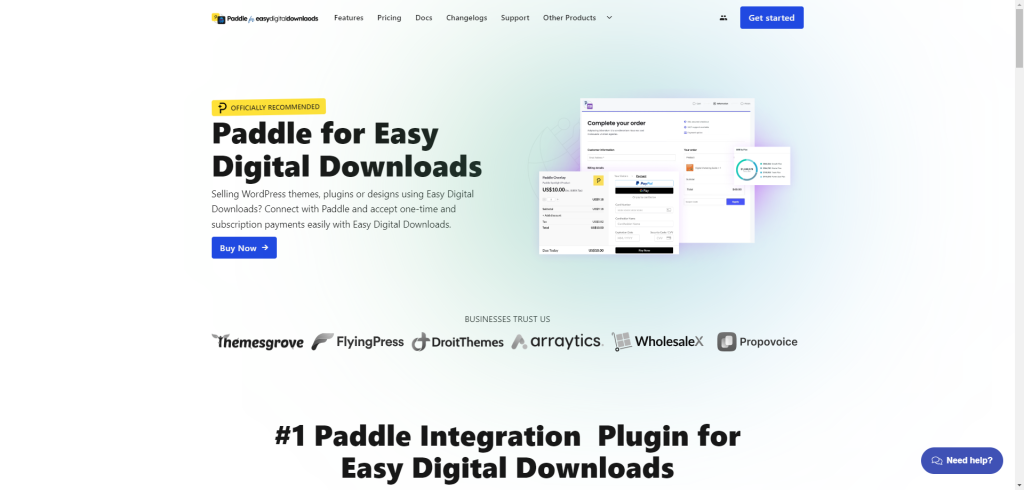
- Targets users of the Easy Digital Downloads (EDD) plugin, a popular platform for selling digital products on WordPress.
- Seamlessly integrates Paddle’s powerful capabilities like global payments, subscriptions, tax compliance, and advanced fraud protection within the EDD interface.
- Provides additional features like automatic license generation, discount management, and one-click payouts, all geared towards simplifying and scaling digital product sales through EDD.
Paddle for WooCommerce
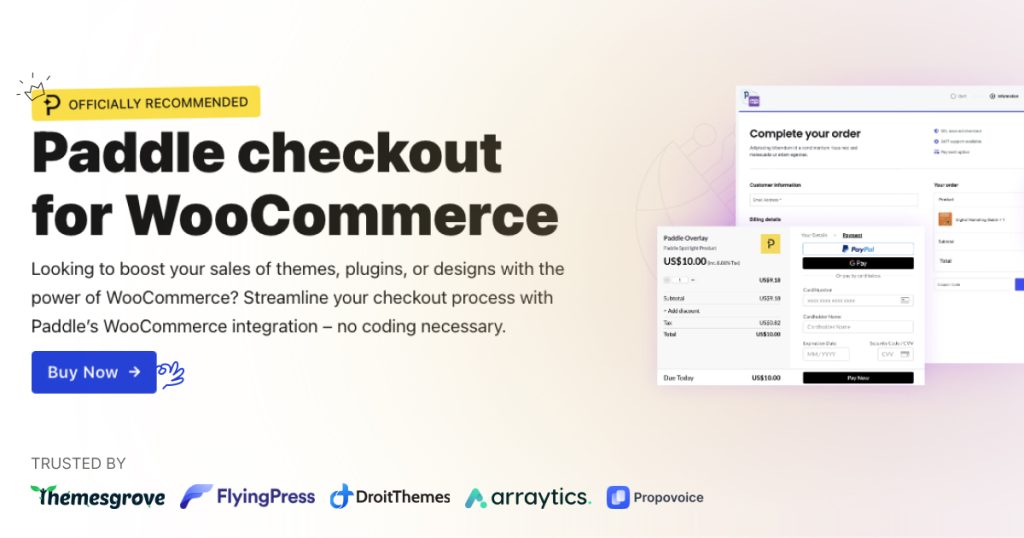
- Caters to users of the WooCommerce plugin, a widely used eCommerce platform for WordPress.
- Connects WooCommerce websites with Paddle, enabling secure and smooth processing of one-time and recurring payments for physical and digital goods.
- Offers features like convenient checkout experiences, international tax handling, and robust subscription management tools specifically designed for WooCommerce environments.
Essentially, both Paddle for EDD and Paddle for WooCommerce leverage the benefits of the Paddle payment gateway but make them readily accessible and enhance their functionality within the familiar interfaces of EDD and WooCommerce, respectively. This makes them ideal choices for WordPress users already comfortable with these plugins and wanting powerful payment solutions without leaving their preferred platform.
Supported Payment Methods
Paddle: Think global citizen here. With over 200 currencies, popular e-wallets like Apple Pay and Alipay, and adaptable local payment methods like SEPA Direct Debit, Paddle embraces your customers’ preferred payment options anywhere in the world. This inclusivity fosters trust and smoothens cross-border transactions, especially in emerging markets.
Gumroad: Keeps payments simple by integrating with Stripe to facilitate transactions. This allows creators to accept all major credit cards like Visa, Mastercard, American Express, and Discover, as well as digital wallets such as Apple Pay and Google Pay. While the payment options are more standard compared to Paddle, Gumroad’s focus is on providing a seamless checkout experience for customers accustomed to these widely-used payment methods. The platform does not currently support alternative payment options like bank transfers or regional e-wallets, catering primarily to a global audience comfortable with credit card and mainstream digital wallet payments.
Global Reach
Paddle: Picture borderless commerce at its finest. Paddle enables sales in 200+ countries, complete with localized checkout experiences tailored to language, currency, and cultural preferences. Paddle simplifies international expansion, new product launches and more. This creates a seamless and familiar experience for customers worldwide, boosting conversion rates and brand loyalty.
Gumroad: While Gumroad may not provide as extensive localization features as Paddle, it does offer multi-currency support, allowing creators to sell their digital products and services to a global audience. Customers can purchase from Gumroad storefronts using their preferred currency, enhancing the buying experience. However, Gumroad does not currently offer fully localized checkout experiences tailored to specific languages or cultural preferences. Its global reach is primarily facilitated through its seamless integration with major payment providers like Stripe, which enables transactions from various countries and regions worldwide. For creators targeting a mainstream international audience comfortable with English-language interfaces, Gumroad’s multi-currency support can be sufficient.
Currency Conversion
Paddle: Say goodbye to manual calculations and potential pricing errors. Paddle handles automatic currency conversion at competitive rates, ensuring a hassle-free experience for both you and your customers. This removes a technical hurdle and fosters trust in your global pricing strategy.
Gumroad: Gumroad simplifies multi-currency transactions by automatically converting prices based on the customer’s location and selected currency. This eliminates the need for manual currency conversions, providing a seamless checkout experience for global customers. Gumroad utilizes real-time exchange rates from their payment processor (Stripe) to ensure accurate pricing across currencies. While the platform may lack advanced currency pricing tools found in Paddle, the automatic conversion alleviates a common pain point for individual creators selling internationally. Customers can make purchases in their local currency without creators having to manage complex global pricing strategies manually.
Fraud Prevention
Paddle: Paddle leverages advanced fraud detection algorithms and machine learning techniques to identify and mitigate potential risks. Their system analyzes various data points, including IP addresses, purchasing patterns, and device information, to flag suspicious activities. Additionally, Paddle offers customizable fraud filters, allowing merchants to define their own rules and thresholds based on their specific risk profiles.
Gumroad: Similar to Paddle, Gumroad uses fraud detection algorithms that analyze data points like IP addresses and purchase history to identify suspicious transactions. These transactions are assigned a risk score, and those exceeding a certain threshold are flagged for manual review by a team of specialists. Gumroad also emphasizes account security as a fraud prevention measure, offering two-factor authentication to make unauthorized access to creator accounts more difficult. While Gumroad utilizes these measures, it’s important to remember that staying vigilant and reporting any suspicious activity to Gumroad’s support team is crucial for creators.
Chargeback Management
Paddle: Paddle takes a proactive approach to chargeback management. Their system automatically responds to chargeback notifications, gathering relevant transaction data and evidence to support merchants’ cases. Paddle also provides detailed chargeback reporting, enabling businesses to identify patterns and potential areas of improvement in their processes.
While Paddle handles the initial chargeback response, merchants are responsible for providing additional documentation or information if needed during the dispute process. Paddle’s knowledge base offers guidance on best practices for chargeback prevention and management.
Gumroad: When it comes to chargeback management, Gumroad relies on the procedures and tools provided by its payment processor, Stripe. Stripe has built-in chargeback protection measures and provides merchants with detailed data and evidence to respond to chargeback disputes.
However, Gumroad itself does not offer any dedicated chargeback management features or tools beyond what Stripe provides. Creators selling through Gumroad are responsible for monitoring and responding to chargeback notifications, as well as providing any additional information or documentation required by Stripe during the dispute process.
While this approach may be less streamlined compared to Paddle’s automated chargeback response system, it aligns with Gumroad’s focus on simplicity and reliance on third-party integrations for core payment processing functionalities.
Gumroad does not currently offer extensive guidance or resources specifically tailored to chargeback prevention and management. Creators may need to refer to Stripe’s documentation and best practices for handling chargebacks effectively.
Reporting and Analytics
Paddle: Dive deep into data-driven insights with rich analytics powered by ProfitWell Metrics. This tailor-made solution for subscription businesses allows you to benchmark key SaaS metrics against industry data, utilize predictive modeling to identify at-risk accounts, and access API pipelines for data-driven decision-making. This eliminates the need for separate analytics tools and empowers you to optimize your pricing, churn reduction strategies, and expansion plans.
Gumroad: Gumroad offers basic sales analytics that provide creators with insights into their customer base and product performance. You can track metrics like sales figures, customer demographics, and product popularity.
However, compared to Paddle’s ProfitWell Metrics integration, Gumroad’s reporting lacks advanced features like subscription analytics, churn prediction, and industry benchmarking. While Gumroad’s data can be helpful for understanding basic trends, creators looking for deeper insights and data-driven strategies might need to integrate additional analytics tools.
Integrations
Paddle: Streamline your workflow with a vast library of integrations covering popular eCommerce platforms, CRMs, marketing tools, and more. This seamless ecosystem allows for automated tasks and data exchange, boosting efficiency and productivity. Additionally, dedicated solutions like Paddle for EDD and Paddle for WooCommerce cater specifically to WordPress users.
Gumroad: Gumroad offers a more limited selection of integrations compared to Paddle’s extensive library. While Gumroad integrates with some basic marketing tools like email marketing platforms, creators seeking deeper functionality or integration with specific CRMs or analytics tools might need to find workarounds or explore third-party solutions. This can add complexity to managing your workflow compared to Paddle’s all-in-one approach.
Distinct Features of Paddle and Stripe
Paddle Distinct Features
Flexible Monetization Tools: Paddle makes it easy for SaaS companies to experiment with pricing models and optimize monetization strategies over time. Its metered billing and usage-based pricing features support innovative models like trials, free plans, credits, and more. This flexibility allows businesses to fine-tune their offerings to maximize revenue.
Comprehensive Tax Management: For companies selling software globally, tax compliance is a major headache. Paddle provides complete VAT, GST and sales tax solutions out-of-the-box for Europe, North America, Australia and beyond. This saves teams the pain of managing different jurisdictional rules and filings.
Instant Global Payouts: Paddle offers one-click payouts directly to bank accounts across the world, with daily transaction reconciliation. This level of speed and transparency for global payments is extremely rare in the payments industry. Sellers can access their earnings instantly no matter where they are located.
Gumroad Distinct Features
Streamlined Creator Experience: Gumroad’s key strength lies in its simplicity and ease of use for creators. The platform provides a seamless experience for setting up digital product listings, with minimal technical overhead. This low barrier to entry makes it an attractive option for independent creators, artists, and those new to selling online.
Flat pricing: Gumroad offers a flat 10% pricing option on every sale, which simplifies the payment process for the customer. Essentially, Gumroad makes money only if the customer makes money. This flexible and lenient model can be particularly useful for creators building an audience or experimenting with different business strategies.
Built-in Email Marketing and Audience Management: Unlike Paddle, which focuses primarily on payment processing, Gumroad includes built-in tools for email marketing and audience management. Creators can easily import existing email lists, send broadcasts, and leverage automated workflows to engage with their customers and grow their audience directly within the Gumroad platform.
Lightweight DRM and License Key Generation: For software developers and creators selling digital content, Gumroad provides basic digital rights management (DRM) features and the ability to generate license keys. While not as robust as dedicated licensing solutions, these tools can help protect intellectual property and manage access to digital products.
Pricing and Fees
When choosing a payment services provider, one of the most crucial considerations for any business is costs. Between payment processing rates, platform fees, and additional hidden costs, expenses can quickly pile up. In this section, we examine and compare the pricing models of Paddle and Gumroad.
Paddle Pricing
Paddle offers an all-inclusive, transparent pricing model covering payments, subscription billing, tax compliance, fraud protection, and more under one platform. There are no hidden fees or additional costs.
Their pay-as-you-go pricing starts at 5% + 0.50¢ per transaction, delivering essentials like global payments, built-in tax compliance, chargeback protection, and fraud screening.
Paddle provides customized pricing for rapidly scaling or large enterprises to unlock additional premium capabilities like migration services, implementation support, and dedicated success management.
It’s important to note that there are services, Paddle for EDD and Paddle for WooCommerce, that offer customized pricing plans suited for the specific needs of WordPress sites, taking into account transaction volume, subscriptions, and other factors. These services both start at $89/year. For more detailed information visit this link.
Gumroad Pricing
Gumroad keeps things simple and potentially cheaper for creators with its flat transaction fee structure, typically starting at 10% (though a free plan with a higher fee might exist). This fee sits alongside standard payment processing fees. While Paddle offers a wider range of features and scalability for established businesses, Gumroad’s transparent pricing and focus on low fees can be ideal for creators prioritizing affordability and a user-friendly experience.
Ease of Use and Support
When evaluating a billing and payment platform, ensuring a positive user experience through intuitive interfaces and helpful resources is key. Both Paddle and Gumroad have invested in creating intuitive interfaces and providing robust support channels to ensure a seamless experience for their users.
For Paddle, easy-to-configure billing models, actionable customer insights, tailored gaming monetization features, and localized checkout experiences are top strengths that underpin their commitment to user-focused design principles. Hands-on support and 95%+ customer satisfaction gives Paddle users peace of mind during launch and expansion stages.
Paddle offers a comprehensive knowledge base, community forums, and email and live chat support channels. These resources provide merchants with access to detailed documentation, troubleshooting guides, and direct support from Paddle’s experienced team.
Testimonials from CEOs attribute considerable operational efficiencies and cost savings to Paddle’s ability to minimize billing administration overheads. Access to ongoing revenue metric benchmarking against wider industry subscription data also provides data-driven assistance.
While Gumroad places a strong emphasis on simplicity and ease of use for creators, it may lack some of the more robust support resources and advanced interface options found in Paddle.
Gumroad’s user interface is designed to be intuitive and straightforward, allowing creators to quickly list and manage their digital products without extensive technical knowledge. The platform’s focus on minimalism means creators can get started with selling digital content relatively quickly compared to more complex e-commerce solutions.
In terms of support, Gumroad offers an email-based support system and a comprehensive knowledge base that covers common questions and issues. However, it lacks live chat or phone support options, which may be less convenient for creators who require immediate assistance.
While Gumroad’s interface and support resources are well-suited for individual creators and small businesses with basic needs, they may not provide the same level of depth or customization options as Paddle’s offerings. Larger businesses or those with more complex requirements may find Paddle’s comprehensive support channels and advanced interface features more appealing.
That being said, for creators prioritizing a hassle-free experience and focused on quickly getting their digital products to market, Gumroad’s streamlined approach and emphasis on simplicity can be a significant advantage, minimizing the learning curve and potential technical hurdles.
You may also read: 7 Best Gumroad Alternatives That You can Use Right Now!
Security and Compliance
With payment platforms processing valuable customer data, having rigorous security protocols and compliance with privacy regulations is non-negotiable. We examine how Paddle and Gumroad stack up on key parameters of trust and transparency for customers.
Paddle offers best-in-class security reinforced through adhering to SOC 2, GDPR standards, undergoing regular pentests/audits, and being PCI DSS Level 1 certified – the most stringent level. Their security portal offers in-depth documentation around policies, procedures, recovery metrics, access control, and development practices.
With AWS cloud hosting, role-based access controls, MFA authentication, and advanced threat monitoring via SIEM systems, they check all the boxes for enterprise-grade security. A dedicated security team and proactive vulnerability disclosure program further underpin their mature posture.
While Gumroad may not have the same level of in-depth security documentation and certifications as Paddle, it prioritizes security and compliance by leveraging the robust security measures implemented by its payment processing partner, Stripe.
Gumroad utilizes Stripe’s secure payment infrastructure, which is PCI DSS compliant, ensuring that customer payment information is handled according to industry standards. Transactions are protected by TLS encryption, and sensitive data such as credit card information is never stored on Gumroad’s servers.
Instead, Gumroad relies on tokenization, where only a secure token representing the customer’s payment method is stored, rather than the actual payment details. This minimizes the risk of data breaches and unauthorized access to sensitive financial information.
Furthermore, Gumroad employs best practices for password storage, using salting and hashing techniques to protect user account credentials securely.
While Gumroad may not provide extensive documentation or certifications specific to its platform, its integration with Stripe’s industry-leading security measures ensures a reasonably secure environment for processing payments and handling customer data.
However, it’s worth noting that Gumroad does not currently offer advanced security features or configurations for enterprises with stringent security requirements. Its security posture is primarily focused on meeting the needs of individual creators and small businesses selling digital products.
Use Cases and Recommendations
With a detailed analysis of core capabilities, security, pricing, and ease of use behind us – we wrap up with recommendations on ideal customer profiles who stand to benefit the most from Paddle and Gumroad respective offerings.
Businesses Who Are Best Suited for Paddle:
Given its robust feature set and premium pricing, Paddle shines best for well-established businesses with complex global operations including:
- Mid-market to enterprise SaaS companies earning over $10M+ in revenue
- Gaming studios with 50,000+ users and multi-SKU monetization
- Digital publishers generating high 6-7 figure subscription income
- WordPress-based eCommerce and digital download businesses. Paddle for EDD and Paddle for WooCommerce are tailor-made for these platforms, offering powerful features and seamless integration to help your WordPress site thrive
Specifically, the ability to customize sophisticated subscription billing constructs, executive sales tax calculations across 200+ countries, and tap detailed cross-border consumer spending data make Paddle worthwhile for expanding companies.
Those needing niche accommodations like metered pricing models for API usage, certificate generation for software licenses, or risk management around fluctuating cross-border tax jurisdictions will find that they have unmatched capabilities with Paddle.
Businesses Who Are Best Suited for Gumroad:
Gumroad’s user-friendly interface and focus on affordability make it a perfect fit for several creator profiles:
- Artists, musicians, writers, and other solo creators selling digital products like ebooks, music tracks, courses, or design assets can easily set up a storefront and start selling with minimal technical knowledge.
- Small businesses and startups with a limited product range can leverage Gumroad’s basic features and low fees to test the waters of online sales before scaling up.
- Gumroad caters to creators with simpler subscription models, allowing them to offer recurring memberships or content access plans without needing advanced subscription management tools.
Gumroad shines for its user-friendliness and affordability. Creators with minimal technical knowledge can set up a store and manage sales quickly. The flat fee structure and lack of hidden costs maximize profit margins, especially for moderately priced digital products. Built-in marketing tools like email marketing and coupon codes further empower creators to promote their offerings and attract customers.
However, Gumroad’s limitations become apparent for complex business models. It might lack the advanced features or comprehensive integrations with external tools needed for intricate subscription management or specific workflows. Additionally, while Gumroad handles moderate sales volumes well, high-volume businesses might require more robust solutions as they scale.
Paddle vs Gumroad: Choosing the Right Platform for Your Needs
Paddle and Gumroad are both powerful tools for selling digital products, but they cater to different needs. Here’s a quick recap to help you decide:
Choose Paddle if:
- You’re a well-established business with complex operations.
- You need advanced features like customizable subscriptions, robust tax compliance tools, and detailed sales analytics.
- You plan to scale rapidly and anticipate high sales volume.
- You require integrations with various marketing, CRM, and analytics platforms.
Choose Gumroad if:
- You’re an individual creator or a small business with a limited product range.
- You prioritize ease of use and a user-friendly interface.
- You want a cost-effective solution with transparent fees.
- You offer moderately priced digital products and have simpler subscription needs.
Ultimately, the best platform depends on your specific circumstances. Paddle offers a comprehensive feature set ideal for scaling businesses, while Gumroad provides a user-friendly and affordable option for creators starting out. Consider your budget, technical expertise, product complexity, and future growth plans when making your decision.

